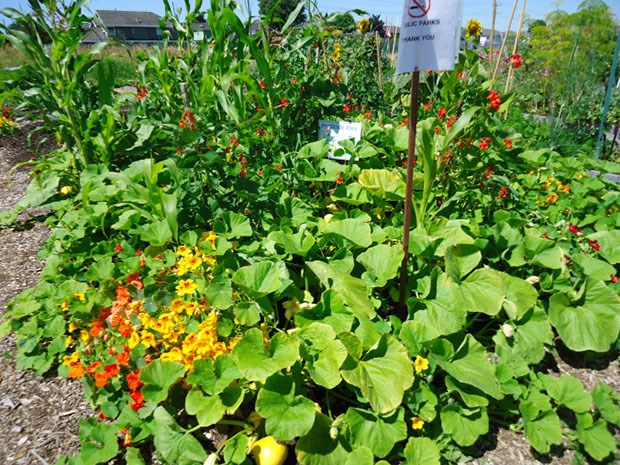Keep it organic - One thing I leaned over the years is Mother Nature knows how to take care of her garden. She doesn’t add chemical fertilizers or use insecticides. She lets nature take care of pests and diseases naturally. So why are we not doing the same? Growing organically was something our grandparents did. Along came the 1950s and chemicals were invented to make our lives easier but at what expense? Fast forward to this century and many of us are trending to organic growing. I have been growing organically for twenty years. So what does organic mean?
When you grow organically you are not using any pesticides at all. Pesticides cover everything from insecticides, fungicides and herbicides. Here in Delta, we live in a pesticide free community. So what are the organic alternatives? I like to use fish fertilizer, Gaia brand fertilizers and home blends as well. Yes, you can make your own fertilizers. So does it work? It does. What you need to do is practice integrated pest management. Take a walk every day in the garden and look at whats going on around you. See a few aphids, get the hose and wash them off or squish them if you like. Nipping problems as soon as you see them makes for a healthier garden. When you stop using pesticides, the beneficial insects start to call your garden home.
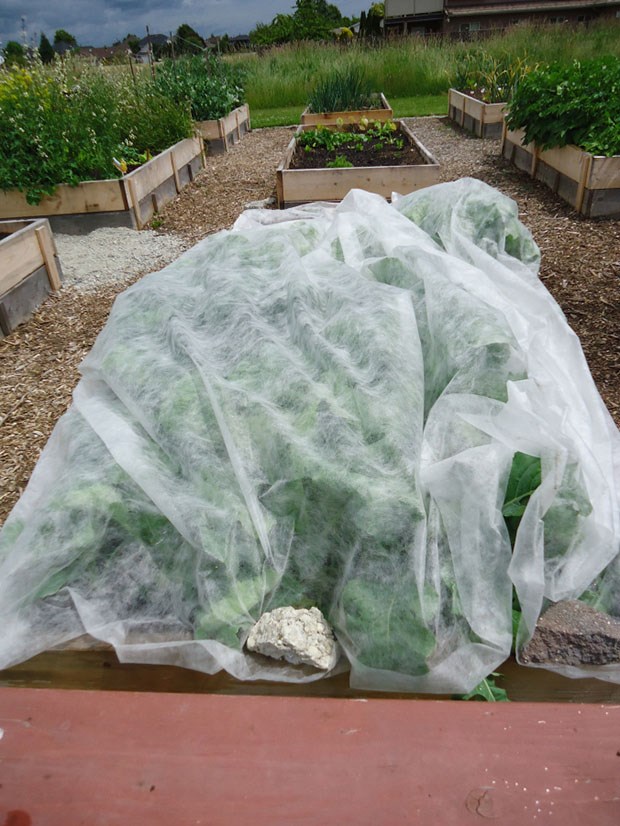
One of my favourite ways of protecting my garden from insect damage is by using Reemay. It’s a floating row cover and it prevents insects from laying eggs on your vegetables but you can still water through it. It’s very light and you place it over top and leave a lot of slack so that as plants grow it can move with them. No more cabbage moth larva for this gardener!
You need to learn how to attract beneficial insects and wildlife to the garden. Once you stop using chemicals in the garden they will return.
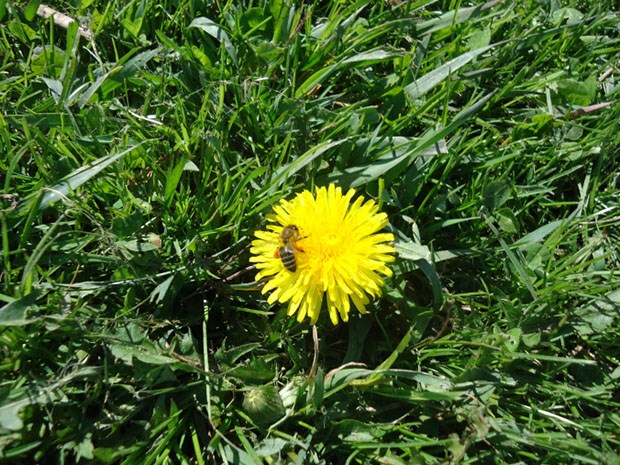
Here you can see a bee enjoying the pollen from a dandelion in my lawn. Did you know the dandelion is one of the first plants in spring for pollen? Its taken a few years but once you eliminate all drugs in the garden a natural balance will occur. So what are examples of good insects. About 90 per cent of insects are good ones. The problem is we often don’t know enough about them.
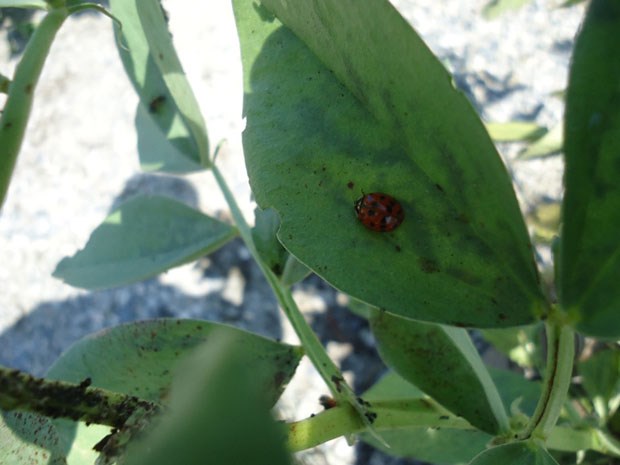
Can anyone guess what this is? The ladybug is smart and lays her eggs near plants that attract aphids. This is a broad bean plant in early spring, loaded with black aphids and their excrement. One ladybug can eat more than her body weight in aphids in a day. Think about it, if we didn’t have any bad bugs what would the good bugs eat?
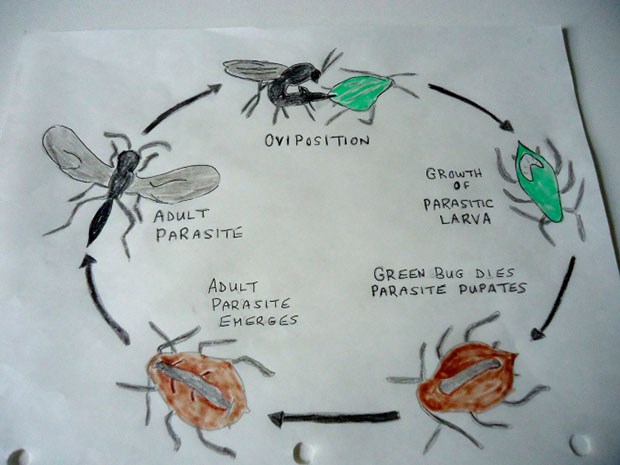
Beneficial insects like this parasitic wasp actually lay eggs on all sorts of caterpillars. They insert their eggs directly into the host caterpillar. The larva of the parasitic wasp literally eats the caterpillar alive. When the larva eat their way out, the caterpillar dies. When the larva are inside the caterpillar they use it as an incubator. I know, like a scene from aliens the movie, right? Spiders are good bugs although we tend to not like them. Spiders eat many other pests in the garden and we see house flies in their webs all the time. Place mason bees homes in your gardens so you have early pollinators. You will also find the birds are great pest control. They will fly right up to the roses by my window and nip off any aphids I have. I can actually say now that I don’t get aphids. Its taken a few years but once you eliminate all drugs in the garden a natural balance will occur.
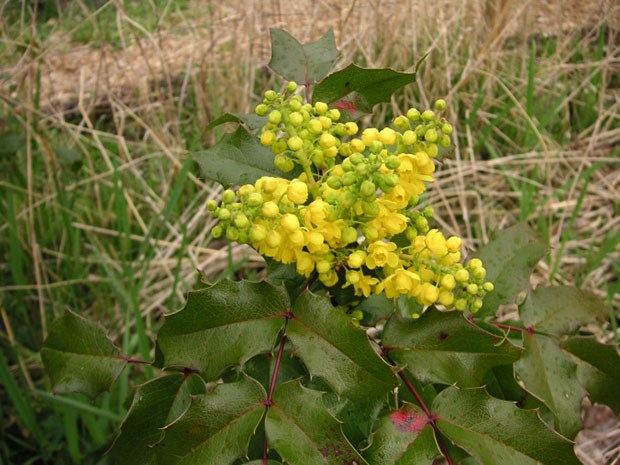
Attracting beneficials with plants-Plant to attract them by using native plants as well as cultivars. Plants such as Mahonia or Oregon Grape are evergreen and it has flowers and fruit. The fruit is loved by birds and the plant is tough enduring dry conditions.
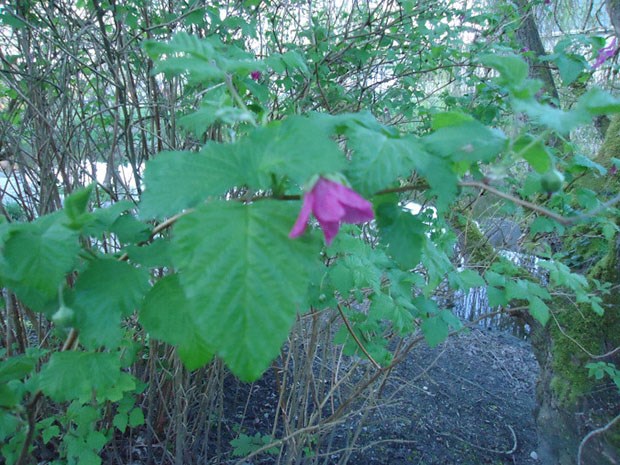
Plants such as Salmonberry are native here and produced lots of edible fruit. They tend to sucker so use them in areas where you need good coverage or as a privacy screen or background plant. This grows naturally along the water at the back of my garden. It doesn’t sucker any worse than raspberries.
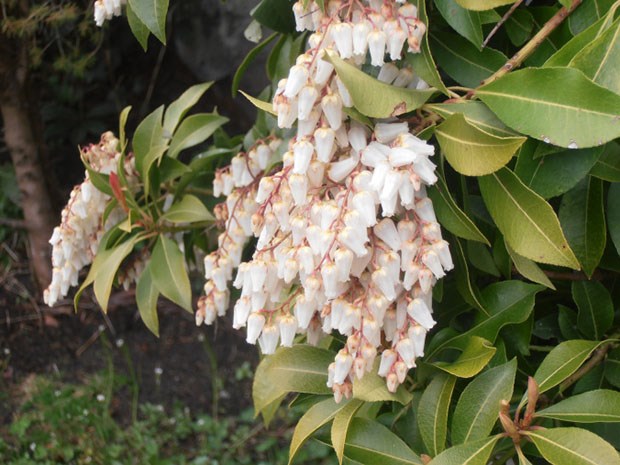
Pieris japonica is commonly known as the Lily of the Valley shrub. Its one of the first plants that attracts mason bees so think about having at least one of these in your garden. They are slow-growing, evergreen to about six feet with flower colours ranging from white to pinks and purples. They also can have excellent spring and fall colour. The tubular flowers are attractive to many pollinating insects.The idea is to have something blooming in your gardens year round.
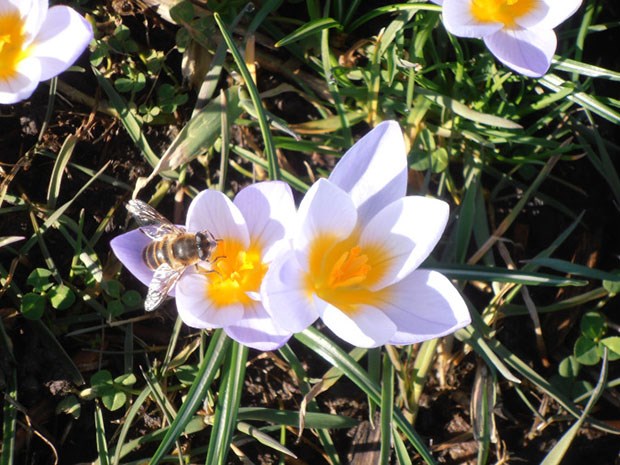
I took this photo in February and the bees were all over the Crocuses. Heather is also a good plant to attract insects. Depending on the variety, you can have plants that bloom in spring, summer and fall. Other cultivated plants that will attract beneficial insects are ones with what I call flat flowers. The flat heads of some of the flowers provide a helicopter landing pad of sorts for insects. Rudbeckia or black-eyed Susan is another good plant to have. Its long bloom time from July to late fall means it attracts pollinators all summer. Coreopsis is another perennial flower to attract insects. This only grows to about a 15 inches high and wide and flowers for a long period as well. If you are looking for annuals to do the trick try using Lemon Gem Marigolds. They bloom their hearts out for months on end. Add some Asters for fall colour as they are a bee magnet.
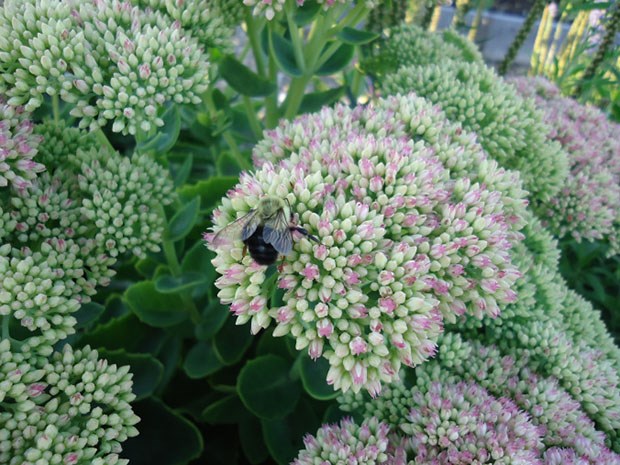
I know Sedum is so over used but this plant attracts bees better than any other. Leave the seed heads on over winter for birds to enjoy. The planting of Sweet Alyssum in the garden is sure to bring pollinators to the garden. I like to add Alyssum to all my vegetable garden beds.
Design your garden in layers like you see in a forest. You want to add tall trees as they provide shade and that cools our homes in the summer and keeps them warm in the winter reducing your heating bill. Once you have your tall storey in add a lower storey of evergreen and deciduous shrubs and then your smaller herbaceous perennials at the foreground. Remember to use leaves from your trees as mulch over your gardens. They provide a warm blanket in our gardens as we rarely get enough snowfall to properly protect our plants from a hard winter frost. Trees and shrubs add nesting areas for both insects and birds. The birds will eat many insects if they are welcome in your garden.
Watering - With this mild winter we had very little snow and I worry that this summer will be another warm one. This will be year three of a hot summer. Now is a good time to think about where you will be planting. Choose plants that have high water needs and group them together so you can water them at the same time.
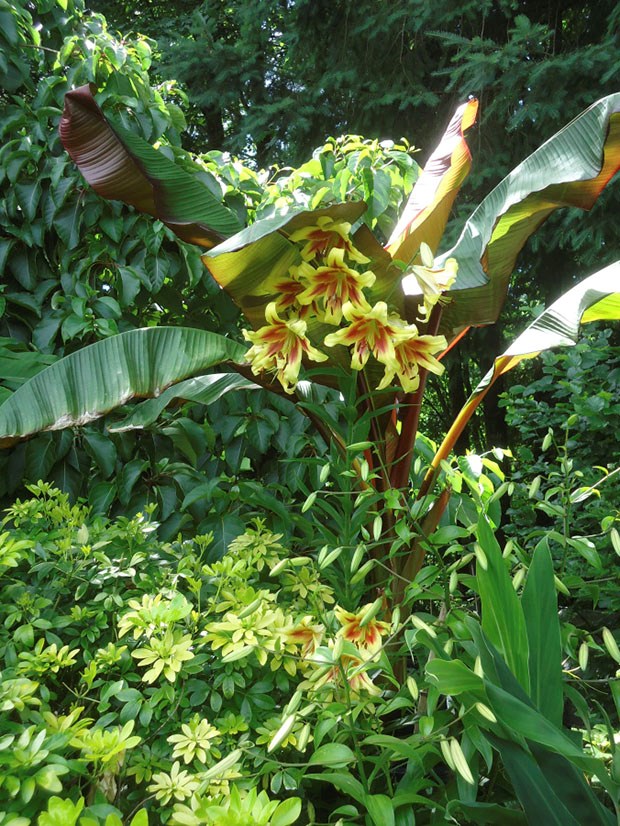
So what plants use the most water? Tropical plants are one. With their large leaves they consume more water. So do annual flowers as they have a shallow root system. Use more perennial flowers and less annuals to save water. Lawns also consume more water so consider reducing your lawn, cutting back on watering. Grass is a cool season plant that naturally goes dormant in summer and comes back when temperatures cool in the fall. Leave the grass to grow a bit longer, shading grass roots from the hot sun. If you have a mossy area why not convert it to a shady sitting area in the garden? We often plant our gardens and give all our plants the same amount of water. We tend to over water. You want the plant roots to go deep down into the soil to look for water. Water longer and wait a week between watering. An inch of water per week is enough. Place a tuna can outside under the sprinkler to see how much you are using. Can you hold back some as we go into summer? How about watering well and applying a mulch. I like using drip hoses which only drip water to plant roots. I don’t water my lawn in the summer at all, just the vegetable beds and some of the perennial flowers and containers.
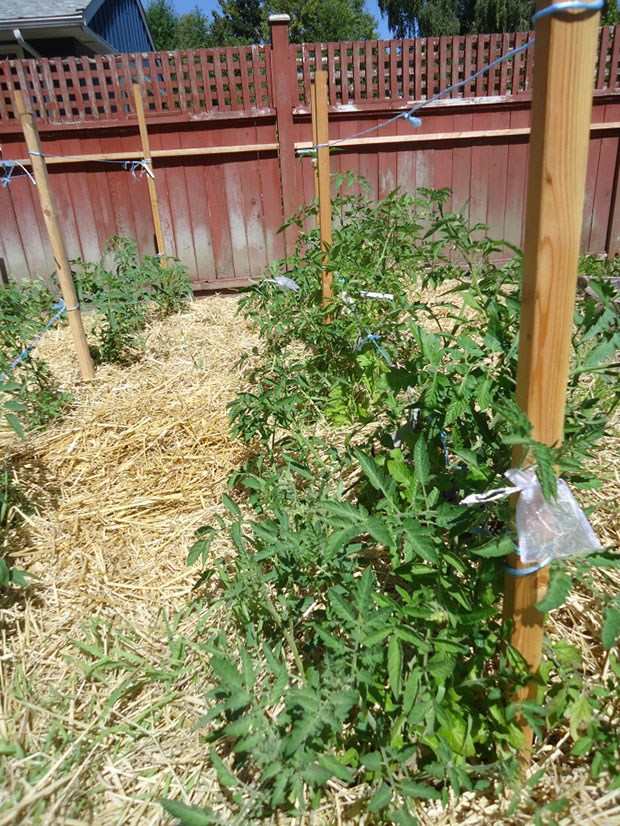
Last year I used a bale of straw between the rows in my vegetable garden. The straw kept the soil moist. I checked the soil moisture by feeling it under the straw. I ended up watering every two weeks and that was it. Using mulch not only helps to retain moisture it can cut down on weeding. Wouldn’t it be fun to never have to pull a weed? You can also use bark mulch. Bark mulch can be placed on garden beds to keep the soil moist. In the fall I have lots of leaves and we place them on the garden all winter as a mulch. It not only protects tender plants but it increases the decomposers in the garden and they improve soil structure. In the spring I will pull back mulch if it isn’t decomposed so that spring flowers can be seen. Extra leaves can be composted.
So water with care, use soaker hoses instead of oscillating sprinklers. You want the water to get near the roots of your plants, not the leaves. Water in the early morning if you can as there is less chance of evaporation then. It’s best to make sure your plants go into the night dry. That way you prevent fungal diseases such a mildew. If you are using an irrigation system be sure to turn it off on rainy days and don’t let it water sidewalks and roads. Use a rain barrel to store rain water for your garden. Use this water on your trees , shrubs and flowers. They can be hooked up to your downspout as an effective way to save water.
Recycling in the garden is something I like to do all the time. Before you throw something out, try to think of a way you can reuse it. Even if it’s headed to the recycling bin, ask yourself if you can reuse it first. Yogurt and margarine containers can be made into plant tags or for starting seeds. Newspaper can be made into pots for seeds, bakery containers used as miniature greenhouses, mini blinds cut to make plant labels, old hose can be used as tree supports, broken pots turned into miniature gardens, old headboards used as plant supports at the end of raised beds, twist ties can be used to tie in raspberry canes and plastic bags used for holding your harvested crops.
Try to grow your own food to save money. By growing food close to home or buying locally you are not having food travel thousands of miles to get here. Think about joining a community garden if you don’t have the space or right conditions for a vegetable garden. You can grow food in the ground and in containers. Even if you have a small space there is something you can grow. Think vertical and make use of trellises and arbors to grow up. I liked to think I was being sustainable until last year. We often grow crops that we like without thinking about their perishability. Why are we not growing more storage crops like onions, potatoes, turnip and cabbage? Instead we grow crops like lettuce that last a couple of weeks. Think about growing food that you can can or freeze so you have something to fall back on in the winter. We can’t do that with lettuce. Learn how to cure and store your vegetables over the winter months. It’s easy to learn.
